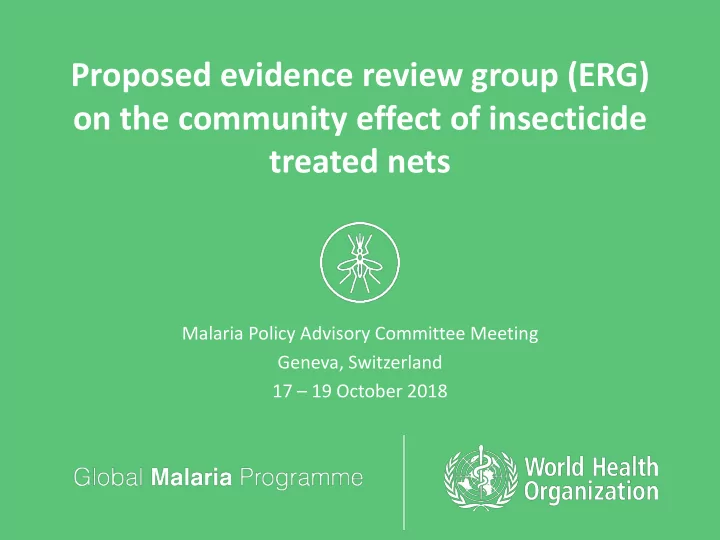

Proposed evidence review group (ERG) on the community effect of insecticide treated nets Malaria Policy Advisory Committee Meeting Geneva, Switzerland 17 – 19 October 2018
Context – part 1 • Support a move from expert opinion to evidence-based recommendations • Articulate certainty of evidence in GRADE tables • Provide evidence-to-decision frameworks for each intervention • Incorporate existing recommendations in attempt to condense large volume of guidance into one resources
Current recommendations
Past recommendation (2007) Page 2. ITNs: Mode of action: By reducing the vector population in this way, ITNs, when used by a majority of the target population, provide protection for all people in the community, including those who do not themselves sleep under nets (1, 2). A recent study has shown that relatively modest coverage ( around 60%) of all adults and children can achieve equitable community-wide benefits (3). Page 8. Full coverage: Since high coverage rates are needed to realize the full potential of LLINs, GMP recommends full coverage of all people at risk in areas targeted for malaria prevention through ITNs, including LLINs. 1. Binka et al. (1998) Impact of spatial distribution of permethrin-impregnated bed nets on child mortality in rural northern Ghana. Am J Trop Med Hyg 59: 80-5 2. Hawley et al. (2003) Community-wide effects of permethrin-treated bed nets on child mortality and malaria morbidity in western Kenya. Am J Trop Med Hyg 68: 121-27. 3. Killeen et al. (2007) Preventing childhood malaria in Africa by protecting adults from mosquitoes with insecticide-treated nets. PLoS Med 4(7): e229.
From past/current recommendations to Guidelines • Evidence underpinning universal coverage recommendation needs to be comprehensively reviewed and be clearly laid out • Recommendation needs to be articulated by means of an evidence- to-decision framework
Context – part 2
The response
Prioritization Cutting the cake differently does not change its size In other words, prioritizing one intervention over another requires de-prioritization of one or more alternatives. The decision to do so should be evidence-based.
Insecticide-treated nets (ITNs) • One of two WHO recommended core vector control interventions • Target since 2007 is universal coverage, which has significant resource implications Note: Universal coverage is defined as universal access to and use of appropriate interventions by populations at risk of malaria.
Vector control & ITN resources
Impact Over 2000 – 2015, an estimated 663 million clinical cases Over 2000 – 2015, an estimated 663 million clinical cases averted, 68% of which by ITNs averted, 68% of which by ITNs, at coverage levels well below universal coverage Bhatt et al. (2015) The effect of malaria control on Plasmodium falciparum in Africa between 2000 and 2015. Nature 526(7572): 207 – 11.
Coverage Koenker et al. (2018) Assessing whether universal coverage with insecticide-treated nets has been achieved: is the right indicator being used? Malaria J 17: 355.
Efficiency: observations • Low coverage (43% in 2013) • Uneven net distribution among households (21% over-allocated) • Over-allocation worsened as net provision increased • Rapid rates of net loss from households (50% lost after 23 months) Bhatt et al. (2015) Coverage and system inefficiencies of insecticide-treated nets in Africa from 2000 to 2017. eLife 4:e09672.
Efficiency: conclusions • Quantity estimated to achieve population access to ITN within universal coverage would in reality yield much lower level coverage household • Identified system inefficiencies are not easily overcome • Diminishing coverage returns for each dollar spent • Cost-effectiveness of pursuing universal coverage rather than a lower operational target must be weighed against alternative malaria control investments Bhatt et al. (2015) Coverage and system inefficiencies of insecticide-treated nets in Africa from 2000 to 2017. eLife 4:e09672.
(Some) key questions • What is the current evidence- base underpinning WHO’s universal coverage recommendation? What are the evidence gaps? • Is the recommendation primarily driven by easier communication and operational considerations, or is there an actual threshold that is needed for ITNs to achieve maximum impact (and/or a community (mass) effect)? • What is the relative contribution of personal protection and a community effect? How may pyrethroid resistance affect these? • Is the community effect generalizable or only applicable in certain settings? • Should countries unable to achieve universal coverage be concerned about this and continue to pursue this goal? • What evidence-based recommendation should be provided to countries unable to finance universal ITN coverage of all at-risk populations?
ERG objective • To appraise a systematic review of the available evidence on the community effect of ITNs, which will include an analysis of the presence/absence/variations of this effect depending on geographical setting, coverage level and the prevalence/intensity of pyrethroid resistance • To advise WHO on whether the findings from the review of the evidence-base on the community effect of ITNs warrant a revision of current WHO guidance on the deployment of ITNs • To review the WHO glossary to verify whether definitions regarding ITNs and their personal and community effect are appropriately captured. If required, the ERG will need to recommend additions or edits to the glossary to ensure that the definitions are valid and appropriate
For MPAC guidance • Is the convening of the proposed ERG meeting supported in principle? • Do the proposed objectives accurately reflect current needs or are modifications to the ERG ToRs required?
Recommend
More recommend